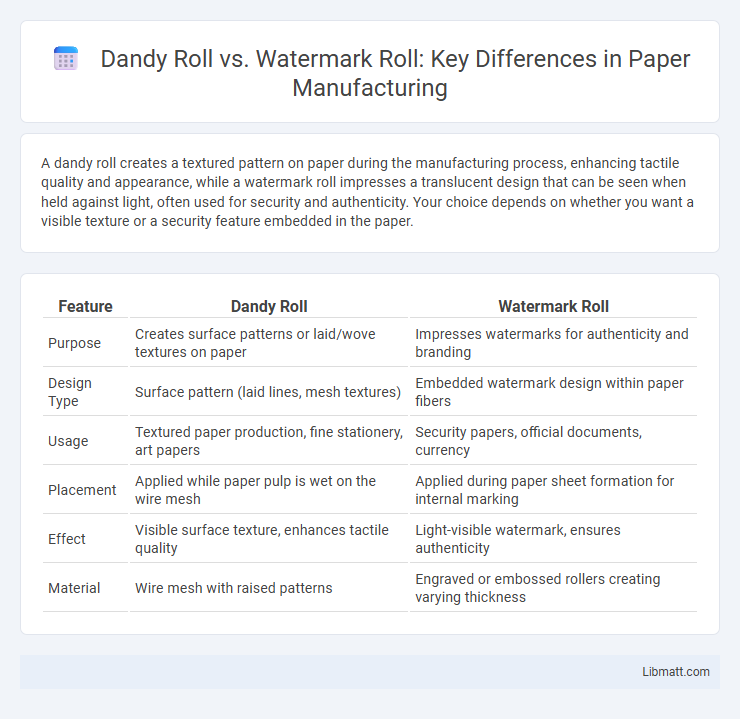A dandy roll creates a textured pattern on paper during the manufacturing process, enhancing tactile quality and appearance, while a watermark roll impresses a translucent design that can be seen when held against light, often used for security and authenticity. Your choice depends on whether you want a visible texture or a security feature embedded in the paper.
Table of Comparison
| Feature | Dandy Roll | Watermark Roll |
|---|---|---|
| Purpose | Creates surface patterns or laid/wove textures on paper | Impresses watermarks for authenticity and branding |
| Design Type | Surface pattern (laid lines, mesh textures) | Embedded watermark design within paper fibers |
| Usage | Textured paper production, fine stationery, art papers | Security papers, official documents, currency |
| Placement | Applied while paper pulp is wet on the wire mesh | Applied during paper sheet formation for internal marking |
| Effect | Visible surface texture, enhances tactile quality | Light-visible watermark, ensures authenticity |
| Material | Wire mesh with raised patterns | Engraved or embossed rollers creating varying thickness |
Introduction to Paper Watermarks
Dandy rolls and watermark rolls are essential tools in paper manufacturing used to create distinctive watermarks that verify authenticity and enhance brand identity. The dandy roll, a lightweight, patterned roller, impresses a semi-transparent design during paper formation, while the watermark roll applies more detailed and durable marks by pressing into the wet fiber sheet. Both techniques rely on manipulating fiber density and thickness to produce visible, yet subtle, patterns that are vital for security and aesthetics in stationery and currency papers.
What is a Dandy Roll?
A Dandy Roll is a crucial tool in papermaking, used to imprint patterns or textures onto the paper surface during the wet sheet forming process, enhancing paper quality and appearance. Unlike a Watermark Roll, which primarily creates translucent designs visible when held up to light, the Dandy Roll embosses surface patterns affecting texture and strength. Your choice between a Dandy Roll and a Watermark Roll depends on whether you prioritize paper texture or subtle embedded designs for brand recognition and security.
Understanding Watermark Rolls
Watermark rolls are specialized tools used in papermaking to create subtle, artistic impressions visible when held against light, enhancing the paper's authenticity and aesthetic appeal. Unlike dandy rolls that produce basic surface textures, watermark rolls embed intricate designs during the wet sheet forming stage, ensuring durability and clarity of the watermark. Understanding your watermark roll's design and manufacturing process is crucial for achieving precise, high-quality watermarks that add value to your paper products.
Key Differences: Dandy Roll vs Watermark Roll
Dandy rolls and watermark rolls serve distinct purposes in paper manufacturing; a dandy roll creates a textured pattern by imparting a subtle laid or wire pattern onto the pulp, enhancing surface texture and strength. Watermark rolls embed a translucent image or logo within the paper by varying its thickness during the wet stage, providing a secure identification feature ideal for authenticating documents. Understanding these key differences helps you choose the right roll type to improve paper quality or ensure product security.
How Dandy Rolls Create Watermarks
Dandy rolls create watermarks by impressing a patterned wire mesh onto the wet paper pulp during the papermaking process, causing variations in thickness that produce visible designs when held against light. This technique relies on the dandy roll's raised designs to selectively compress areas of the paper, enhancing the translucent quality in those regions to form distinct watermarks. Unlike standard rolls, dandy rolls are specifically designed to transfer these intricate patterns that serve as integral security and branding features on paper products.
The Process Behind Watermark Rolls
Watermark rolls use fine wire patterns embedded into the roll surface, creating a translucent image when pressed onto wet paper pulp during the papermaking process. This embossing method ensures precise, consistent watermarks that enhance security and brand identity on specialized paper products. Your paper will display clear, sharp watermarks that are integral to the paper structure rather than merely printed on its surface.
Historical Significance of Both Methods
The dandy roll, invented by John Dickinson in the early 19th century, revolutionized papermaking by imparting textured patterns directly onto the wet paper, serving as the precursor to modern watermark techniques. Watermark rolls evolved from the dandy roll concept, enhancing security and authenticity in documents by embedding detailed watermarks during paper production. Both methods hold significant historical value, marking key advancements in artistic design and anti-counterfeiting measures in the paper industry.
Advantages and Limitations of Dandy Rolls
Dandy rolls provide a cost-effective method for creating textured patterns and light watermarks on paper, enhancing its aesthetic appeal and improving printability by roughening the surface. However, they have limitations in producing deep or highly detailed watermarks compared to watermark rolls, which are specifically designed for complex and high-contrast watermarking. Your choice between dandy rolls and watermark rolls depends on the required watermark quality and production costs.
Modern Applications of Watermark Rolls
Watermark rolls are essential in modern paper manufacturing for producing high-quality security features on banknotes, certificates, and official documents. These rolls precisely create subtle patterns within the paper fibers during production, enhancing anti-counterfeiting measures and brand authenticity. You can find watermark rolls integrated into advanced automated paper machines to meet stringent industry standards for security and durability.
Choosing the Right Technique for Paper Watermarks
Dandy roll and watermark roll technologies each create unique paper watermarks by varying pressure during the papermaking process, with the dandy roll imprinting patterns on the wet pulp and the watermark roll using engraved rollers for finer details. Selecting the right technique depends on your paper's intended use and desired watermark complexity; dandy rolls offer cost-effective, larger-scale patterns while watermark rolls provide high-resolution, intricate designs ideal for currency and official documents. Understanding these differences ensures your watermark serves both aesthetic and security purposes effectively.
Dandy roll vs watermark roll Infographic

 libmatt.com
libmatt.com